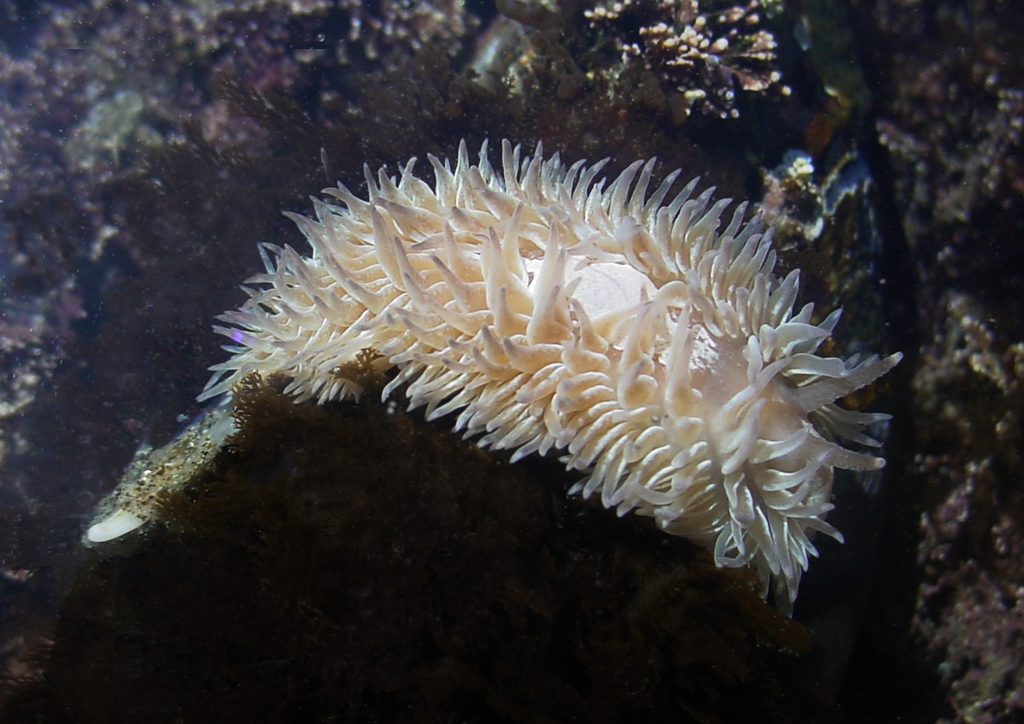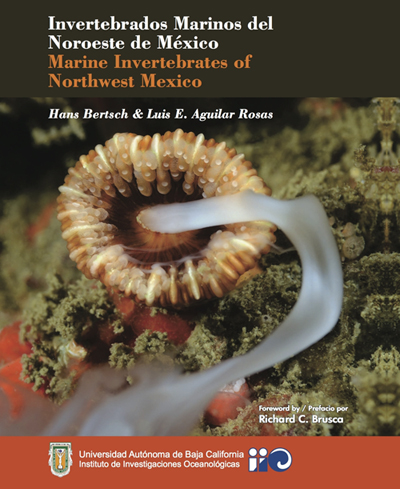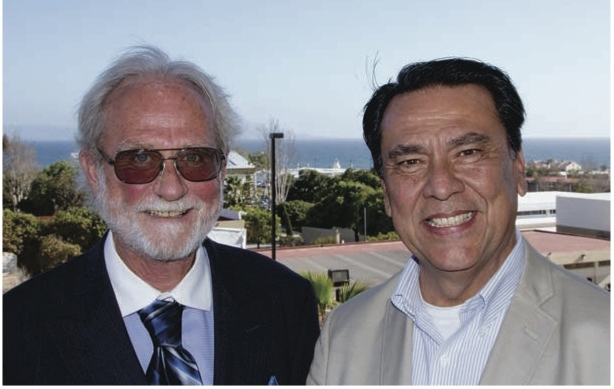 |
Aeolidia loui
Animal photographed at Punta Baja, Baja California, 10 March 2006, by Luis Aguilar Rosas
 |
Aeolidia loui Kienberger, Carmona, Pola, Padula, Gosliner & Cervera, 2016
During the past decade or so, DNA-based research from multiple laboratories (including those of Juan Lucas Cervera, Ángel Valdés and Terry Gosliner) has resulted in numerous taxonomic changes to the Heterobranch fauna of the eastern Pacific and elsewhere. The majority of these studies have re-examined species with wide or even disjunct distribution patterns, resulting in specimens from previously-identified species now considered species in their own right. This is a case in point. Aeolidia papillosa (Linnaeus, 1761) had traditionally been known as a single, wide-ranging species in the northern hemisphere and from Chile. Shallow water specimens from California were assigned to this species (Marcus, 1961; MacFarland, 1966), and deep water specimens were considered A. herculea Bergh, 1894, or A. papillosa herculea. Kienberger et al. (2016) have shown that these animals are actually part of a species complex of sibling species. The Chilean species is A. campbellii (Cunningham, 1871), and A. filomenae (Kienberger et al., 2016) occurs in the northeast Atlantic from Scotland to Portugal. The amphiboreal Aeolidia papillosa is restricted to the northern Atlantic and northern Pacific. In the northeast Pacific it ranges from Cook Inlet, Alaska, to Washington. Both A. herculea and the newly-named A. loui have papillate (or rugose) rhinophores; the other three species have smooth rhinophores. Aeolidia herculea has been reported from Kamtchatka (as the synonym A. grandis Volodchenko, 1941), and in California from the Farallon Islands, Monterey Bay (as the synonym A. farallonensis Gosliner & Behrens, 1996), and Santa Barbara Island (type locality; not Alaska; see Behrens, 2004: 26). Kienberger et al. (2016) reported the distribution of A. loui from Cape Arago, Oregon, to San Diego, California (type locality, Duxbury Reef, central California). Steve Gardner’s images in BOW 407 from La Jolla Shores are of A. loui. In our new book, Invertebrados Marinos del Noroeste de México / Marine Invertebrates from Northwest Mexico (Bertsch & Aguilar Rosas, 2016), we report southern range extensions of Aeolidia loui to Punta Baja, Baja California, and, Punta Norte, Isla de Cedros. The coloration of Aeolidia loui is rather variable, ranging from translucent white to bright orange or brown. There are opaque white marks on the dorsum; some may be covered with light-ochre or brown spots/flecks. Distinguishing this species from the other shallow water species of Aeolidia are the rugose, warty rhinophores, and the bristly, flattened cerata, which are broader at their base. Bertsch (1974) published the first SEMs 4A,4B,4C of the radula of this species (as A. papillosa). Aeolidia loui differs from its deep-water Californian congener by possessing a cleioproctic, not pleuroproctic, anus. |
References
Behrens, David W. 2004. Pacific Coast Nudibranchs, Supplement II. New species to the Pacific coast and new information on the oldies. Proceedings California Academy of Sciences 55 (2): 11-54.
Bergh, Rudolph. 1894. Reports on the dredging operations off the west coast of Central America to the Galapagos, to the west coast of Mexico, and in the Gulf of California, in charge of Alexander Agassiz, carried on by the U. S. Fish Commission Steamer “Albatross,” during 1891, Lieut. Commander Z. L. Tanner, U. S. N., commanding. XIII. Die Opisthobranchien. Bulletin of the Museum of Comparative Zoology at Harvard College 25 (10): 125-233.
Bertsch, Hans. 1974. Descriptive study of Aeolidia papillosa with scanning electron micrographs of the radula. The Tabulata (Santa Barbara Malacological Society) 7 (1): 3-6.
Bertsch, Hans & Luis E. Aguilar Rosas. 2016. Invertebrados Marinos del Noroeste de México / Marine Invertebrates of Northwest Mexico. Instituto de Investigaciones Oceanológicas, UABC, Ensenada, xxxii + 432 pp.
Cunningham, Robert Oliver. 1871. Notes on the reptiles, Amphibia, fishes, Mollusca, and Crustacea obtained during the voyage of M. S. “Nassau” in the years 1866-69. Transactions Linnean Society London 27: 465-502.
Gosliner, Terrence M. & David W. 1996. Two new species of nudibranch mollusks from the Gulf of the Farallones and Cordell Bank National Marine Sanctuaries, central California. The Veliger 39 (3): 348-353.
Kienberger, Karen, Leila Carmona, Marta Pola, Vinicius Padula, Terrence M. Gosliner & Juan Lucas Cervera. 2016. Aeolidia papillosa (Linnaeus, 1761) (Mollusca: Heterobranchia: Nudibranchia), single species or a cryptic species complex? A morphological and molecular study. Zoological Journal of the Linnean Society 177: 481-506.
Linnaeus, Carolus. 1871. Fauna Svecica sistens animalia Sveciae regni, ed. 2. Stockholm. 578 pp.
MacFarland, Frank Mace. 1966. Studies of opisthobranchiate mollusks of the Pacific coast of North America. Memoirs of the California Academy of Sciences 6: 1-546.
Marcus, Ernst. 1961. Opisthobranch mollusks from California. The Veliger 3 (Supplement): 1-85.
Hans Bertsch (hansmarvida@sbcglobal.net ) and Luis E. Aguilar Rosas (aguilarl@uabc.edu.mx )
Instituto de Investigaciones Oceanológicas, Universidad Autónoma de Baja California, Ensenada

|
Send Luis email at aguilarl@uabc.edu.mx
Webmaster's Notes: This book is going to be an indespensable addition to any serious Baja explorer's road map to the underwater nudibranch and invertebrate fauna of Baja California! For a Spanish review of the book, see
Carlos Lazcano
For book sales, please contact Hans Bertsch directly at the present time!
